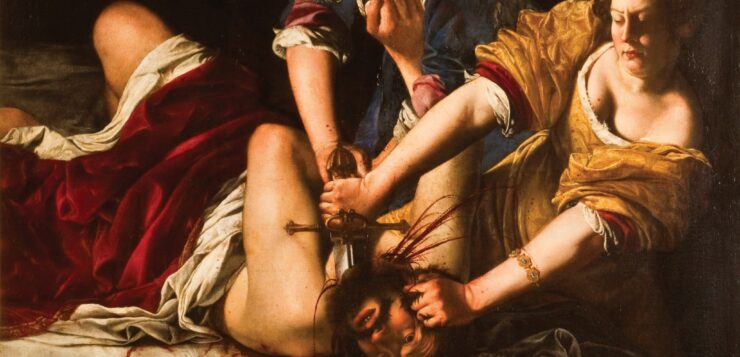“E Vero, e Vero, e Vero”
it’s true, it’s true, it’s true.
This is the ring you gave me and these are your promises!”
(Artemisia’s statement to her perpetrator while being tortured during her rape trial. The judge had her tortured with thumbscrews, as was the norm. Loops of string were wound around her fingers and tightened till she cried ‘E Vero’!)
Women painters are not widely discussed and a list of outstanding painters is likely to miss a woman. Whether it is the result of relatively fewer women artists or the inherent male bias against them (or both) is debatable and an enduring conundrum. Fortuitously, many of them stand out judged even by the most exacting parameters and have presented to humanity some of the finest expressions of human emotions. And yet their talent and accomplishments offer fascinating but perplexing insights regarding their place in history. One such artist of foremost mention is Artemisia Gentileschi.
In the centuries of renaissance that provided a spurt in creative human genius, women still had few opportunities to pursue artistic training or work as professional artists. Artemisia bucked this trend, overcame convention and was to become the first woman member of the Accademia di Arte del Disegno in Florence. Her work got noticed not merely in Italy but was to earn a clientele far beyond her shores.
Artemisia was undoubtedly the greatest female artist of the baroque age and one of the most brilliant followers of the incendiary and violent Caravaggio. Her work, high in quality and fetching in themes, dominated the first half of the 17th century with paintings defined by extraordinary colours, masterful brushstrokes, sartorial brilliance and of course, themes of revenge and reprisal.
Despite losing her mother at twelve, her first paintings appeared when she was just fifteen. Trained by her father Orazio, himself a painter of repute, and largely following the style and passion of the mercurial genius Caravaggio, she became a sincere, hardworking and devoted pupil to her father, who was also to be her collaborator in many of their future works across Europe. And yet, Artemisia’s approach to painting was different from her father’s, taking a highly naturalistic approach over his comparatively idealized works.
The Making of an Extraordinary Woman
Artemisia was raped by her own painting tutor, Agostino Tassi. This occurred when she was a mere teenager. Charges were pressed nine months after the incident because Tassi promised to marry her and restore her dignity, a promise on which he reneged. Artemisia thus had to become an active participant in her rapist’s trial were before reaching a verdict, the judge had her tortured with thumbscrews to verify her testimony. As was the norm then to discourage false accusations, loops of string were wound around her fingers and tightened till she cried out, “E Vero, e Vero, e Vero” – it’s true, it’s true, it’s true. Unbroken, she looked at her rapist and, referring to the loops of string, said: “This is the ring that you give me, and these are your promises.”
The trial lasted seven months and ended in Tassi’s conviction and sentenced him to exile from Rome. But the ordeal scarred Artemisia’s soul permanently. Things were to worsen when Tassi escaped unscathed, having managed a Papal pardon; ironically, much like her mentor Caravaggio once had, for murder. For many years after this, she remained a mere curiosity.
It is a persistent eternal irony of societal mores that while a lecherous Picasso, a lascivious Reuben and a murderous Caravaggio would never get censored or have their works discounted under a moral lens, Artemisia bore the burden of ignominy all her life and could never see herself be appreciated independent of the slur so involuntarily imprinted into her persona.
Her life and art have however been reexamined by scholars in the 20th and 21st centuries and she is now regarded as one of the most progressive and expressive painters of her generation; the recognition of her talents exemplified by major exhibitions of her work at internationally esteemed fine art institutions.
Her Craft and Subjects
There are about fifty-seven works by Artemisia and forty-nine of them feature women as protagonists or equal to men. Most of Artemisia’s paintings feature women from myths, allegories and the Bible, including victims, suicides and warriors. The characters she portrayed intentionally lacked the stereotypical ‘feminine’ traits — sensitivity, timidity and weakness and were portrayed as courageous, rebellious, and powerful.
Artemisia was known for being able to depict the female figure with great naturalism and for her skill in handling colours to express dimension and drama. She understood that the representation of biblical or mythological figures in contemporary dress was an essential feature of the spectacle of courtly life, and she abundantly employed this style in her paintings after carefully and meticulously studying the sartorial elegance and vibrancy of contemporary times.
Some of her best-known subjects are Susanna and the Elders, Judith Slaying Holofernes, Judith and Her Maidservant, Mary Magdalene, Esther before Ahasuerus, Cleopatra and Bathsheba. Judith Slaying Holofernes remains her most representative and popular painting. Holofernes was an Assyrian general who was about to destroy Judith’s home, the city of Bethulia. He invites Judith to his tent and is tricked by her into passing out by excessive drinking. He is then decapitated by Judith with the help of her maidservant, and his head taken away in a basket and brought to Bethulia.
This particular painting has been a focal point in interpreting her artwork and her mind. Its understanding ranges from being seen as a representation of revenge and her rebellious sense of violence to being simply hailed for its brilliant colour scheme, elaborate expression, rich costumes and choice of characters. And yet, it is generally believed that her choice of themes was an expression of the repressed frustration and helplessness she faced in her adolescent life.
The Feminist Hue
For a woman at the beginning of the 17th century, Artemisia choosing life as a painter represented an uncommon and difficult choice. Her evaluation that saw both recognition and prominence came about largely on merit but was also propagated by feminist scholars. She was elevated to the status of feminist icon largely because of the choice of characters she painted and for making a mark in a field dominated and dictated by men. That Artemisia was aware of her position as a female artist and the current representations of women’s relationship to art only reveal the acuity of her perception and grasp of the prevailing realities. In one of her self-portraits – La Pittura – she shows herself as a muse, as an embodiment of art and her artistic proclivities.
But the staunch feminists may have caused noticeable disservice to her by investing historically, intellectually and politically in a narrative that sought to undo a perceived injustice. There does rest a case to portray her as a traumatized but noble survivor whose work became characterized by sex and violence as a result of her experience, but this is likely a post facto feminist-oriented judgment, because merely a century after her death, her work was marvelled as free of feminist baggage. “No one would have imagined that it was the work of a woman. The brushwork was bold and certain, and there was no sign of timidness.”, a critic wrote then.
Legacy
It requires a certain degree of imagination and appreciation of the gender equations prevailing in Italian society then, to truly understand and evaluate the genius of this extraordinarily gifted and resolutely determined woman. Artemisia had to overcome the “traditional attitude and psychological submission to the brainwashing and jealousy of her obvious talent.” But overcome this she did. She was prolific and her paintings spanned over four decades in locations as diverse as Rome, Florence, Venice, Naples and London. She held commissions from the highest echelons of European society, including the Grand Duke of Tuscany, Philip IV of Spain and Charles I of England. Commercially she never had to struggle and continued to get commissions from rich and powerful till the end.
As often happens, her work has seen interpretation from prisms representing contemporary concerns and societal predilections. Feminists have viewed her paintings as an expression of defiance of male dominance and suppression imposed on the women of her time, accentuated by her own traumatic life. The choice of subjects, scenes and characters of her paintings are argued to naturally reveal her underlying angst and resentment. The risk of feminist rediscovery, however, may save her from obscurity only to conscript her into a reductive, triumphal narrative. But this would be a gross injustice to her talent, tenacity and triumphs.
The interpretive evaluation of her work merits a look free of gender lest it colours the true worth of her art and the inspiration behind it. She needs to be recognized in her own right as a fine painter who chose characters from her own convictions and courage, embellished and beautified by her worldview of gender equations. Her brushwork is bold, decisive, certain and far from timid. An impartial evaluation, considering her personality, artistic calibre and the prolific range of her ample and diverse oeuvre will no doubt find her amongst the all-time greats.
While a rare tenacity and energy eloquently defined her personality, what sets her apart and qualifies her as one of the most famous artists of the world, is her communication of a powerful personal vision – something so rare and so close to impossible that it could not be managed by any other Renaissance or Baroque woman. Like Frida Kahlo, Louise Bourgeois or Tracey Emin, she put her life into her art.
Assessed, measured or critiqued from whatever perspective, Artemisia’s oeuvre presents a kaleidoscope of well-crafted, powerful and moving images whose richness of colour, the dominance of texture and the supremacy of theme place her at a pedestal deserving of only the best. That she was able to do so despite her gender and vulnerability adds an almost supernatural aura to her paintings, earning her a place of extraordinary standing. She deserves our commemoration, and not commiseration, for applauding what life gave her.
Roberto Longhi, an Italian critic, best summarized Artemisia as simply “the only woman in Italy who ever knew about painting, colouring, drawing, and other fundamentals.”
This article is part of a series on women through history by author Uday Kumar Varma, former secretary of the Ministry of Information & broadcasting and MSME, Government of India. An ardent proponent of gender equity, Varma writes on women through history who have excelled in their area of passion and defied conventions. You may also like to read about the woman who triggered the abolishment of slavery, Harriet Beecher Stowe, activist Emmeline Pankhurst from England, the lady sniper Lyudmila Pavlichenko from Russia, the American pilot Amelia Earhart or Judge Ruth Bader Ginsberg or just maybe a piece on the Spanish artist Frida Kahlo? And you must read the story of Mata Hari– “Harlot? Oui! Mais traitoress, jamais!” ‘Courtesan! Yes; Spy, never!’





